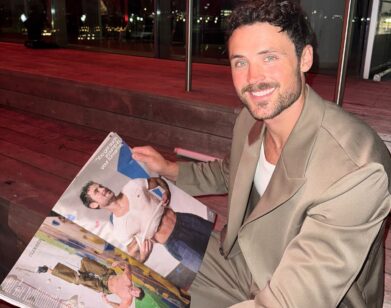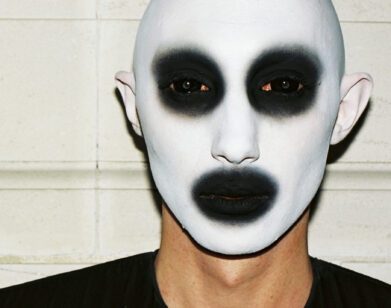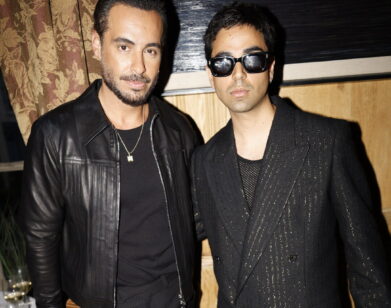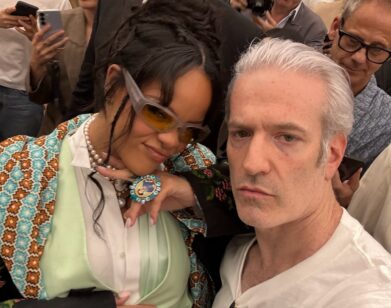For Whom Fashion Tolls: Barcelona Fashion Week
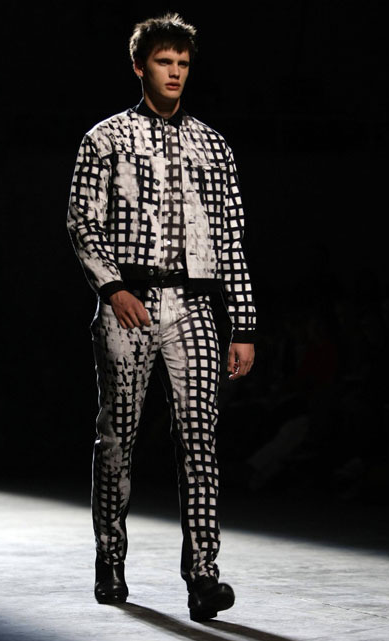
Let the rest of the world tally up the layoffs and search for the light at the end of the tunnel: In Barcelona, the beach and nightlife hub of Catalan Spain, the sun shines every day. The construction workers—and there are a lot of them in this bustling town—appear to be on extended leave, but the people in the streets are smiling. And why shouldn’t they? They’re all beautiful, even the old men who play chess and walk their dogs around the Montjuïc Magic Fountain on the Plaça d’Espanya. Maybe it’s that here the evening begins about 11 PM. That means dinner is just a tapas interlude before Barcelona really kicks up its heels. (LEFT: MONTJUIC MAGIC FOUNTAIN)
Barcelona Fashion is an oxymoron. Who thinks about clothes in a place like this? But in fact, right after the big guns have shot in Paris, 080 Barcelona Fashion, in its third bi-annual session, has become the place to view local Catalan talent, cherry-picked by an international jury for the first time. Twenty-one shows in three days is too many, but it’s more than big fashion’s it bags, it girls and all that luxury shtick.
The style press hung out in front of the show tent pitched next to the magic fountain in Montjuïc, the park on the hill overlooking Barcelona, nearby the Mies van der Rohe Pavilion constructed for the 1929 World’s Fair. The fountain is lit in synchronized rainbow colors at night, a spectacle I haven’t seen since my parents used to take me to the Claremont Hotel in Berkeley in the 1970s, where the formal dining room featured something called “dancing waters.”
The only obstacle to covering the event properly was the hour and a half wait between each show. We quickly found a way to waste dead time, piling into the press tent where Mojitos, generously provided by sponsor Negrita Rum, along with cava, the sparkling white wine that Catalans prefer to champagne, was served nonstop. By the end of the day, around 11 PM, fashion began to seem abstract. Then it was back to Hotel Me, which at 29 floors on the outskirts of Barcelona beckons like a pleasure dome. Designed by French Architect Dominique Perrault, responsible for France’s Grand Bibliothèque Nationale in Paris, the hotel is styled like a nightclub—which makes sleeping there seem highly unlikely until you close the door to your room. (HOTEL ME AT NIGHT)
This year’s session was full of young clothes, street clothes and experimental clothes by young designers running their companies on a shoestring. Many of these collections looked like they were produced in the laboratory of a mad Victorian scientist. Inspired by taxidermy, safaris, wild horses, the progression from analog photography to digital and creatures with extra large heads and Louise Brooks haircuts, an antiquated, monstrous, sci-fi quality was the common thread.
Almost all of these designers are one-man bands. While they’re sketching their next collection, they might also be putting in time behind the counter of their store, or shipping an order to Maria Luisa in Paris. In fact ML head buyer Robin Schulié was on this session’s jury, along with Dries Van Noten’s Jürgen Sailer; Vincent Vantomme from the Belgian style headhunter Link Unlimited; Vicki Beamon of London’s Erickson-Beamon; the German designer Lutz Huelle, who, formerly of Martin Margiela, launched his own collection independently in 2000; and Barbara Franchin, who runs ITS, the celebrated young designer competition held annually in Trieste, Italy. Meeting the jury and the press, style scouts, buyers and fashion aficionados is the real reason independent labels participate. The Barcelona Fashion Award, a 20,000–Euro prize for the best collection, was an added attraction.
In Barcelona, where even the police force once wore espadrilles, style is intrinsically funky. Young Catalan designers are casual and naïve in a sexy way. Miriam Ponsa opened with a collection for chic street urchins: a great rag knit mini dress in sooty grey, black and white stripes, urban pinafores, low crotch jeans, crushed leather jackets, floppy knit caps and what looked like platform socks are what she will be selling in her store in Barcelona’s trendy Born neighborhood. Ponsa was born into the business, which dates to her great-grandmother, who started a silk weaving plant in 1820. She set up her atelier in part of the old family mill and today she sells worldwide.
Local talent Gori de Palma is a multimedia artist who runs his own brand and has designed for Vans. He also directs music videos for local artists and has done ads for Volkswagen and Nutella. It’s hard to imagine skinheads in Barcelona (there’s not enough angst for that), but his “New Skins” collection makes the connection between England’s working class toughs, Teds, and Mods in a mix of extreme acid wash stovepipe jeans and tail jackets worthy of an undertaker. Zazo & Brull (Xavier Zazo, 32, and Clara Brull, 34) were inspired by a visit to a taxidermist in Paris who created imaginary creatures by combining different animals. Theirs is a kind of Goth Edwardiana, like an Edward Gorey drawing, for curvy dresses and jackets with scaly articulated shoulders and hips. Martin Lamothe designer Elena Martin Ortiz was similarly monstrous for fall in leather blousons and dresses with sleeves styled like horse’s heads.
The international designers were tough competition for the laid back Catalans. Japan’s Seïko Taki from Paris took the prize. Taki, in her early 40s, spent 10 years teaching Ikebana, Japan’s painstaking less-is-more art of floral arranging, and was Artistic Director of Chinami Kamishima at Tokyo Fashion Week, before she left for France to study design and work for Anne Valerie Hash. Her own collection, which she launched in 2007, is expansive, disheveled, and utterly feminine. Taki’s “Dry, Chic Women” wear their hair plastered against their foreheads like dancing snakes. They’re dressed in voluminous poet’s blouses—which are in fact blousons—with matching balloon pants in wet-looking metallic silk. (LEFT: AT SEIKO TAKI)
Equally good was Canada’s Mark Fast, 29, who works and shows in London after graduating from Central Saint Martins. Fast has become something of a darling among London’s young designers, scoring the cover of this spring’s AnOther Magazine, selling to Brown’s Focus, and doing a special project for Lanvin in Paris. He’s a painstaking knitter who makes every piece himself, sculpting lacy, falling-apart patterns in second-skin Lycra and complex mixtures of viscose with angora and wool. The result looks like a sexed up younger cousin of Azzedine Alaïa with an heirloom tapestry quality in hourglass shapes with flying, silky fringe.
British milliner Justin Smith, 29, is another hands-on freak from London, Smith began his professional life as a hairdresser for which he won many awards before he discovered his true calling, hats. He produced his entire animal-inspired collection in denim. which he sewed, sculpted, knitted in rag strips and denim dyed yarns. Cowboy hats come with a Sherpa skullcap lining to cover the ears and the back of the neck and one floppy wide brim has a detachable elephant trunk mask. The knit caps look almost banal until you spot the reptile scales and hippo ears.
Raphael Hauber, 31, produces T-shirts and other casual staples for his Postweiler Hauber brand in Germany. This sounds simple, but Hauber works hard to make it complicated. This season he collaborated with photographer Heinz Peter Knes on the disappearance of analog photography. It takes two obsessive, German conceptualists to apply an abstract idea like this to clothes. “Informative” parts of Knes’ images were cut out and printed on T-shirts with a mesh “grid” layer on top for a faded view like looking at the world through curtains. (LEFT: AT HAUSER)
Neils Klavers, the Dutch designer who pioneered the concept of repetitive pieces as in a coat made of five coats layered one on top of the other when he debuted in the late 90s, inspiring so many others including Viktor& Rolf, showed his gentler side under the Klavers van Engelen label he designs with partner Astrid van Engelen. Their collection is full of perfectly liquid harem draping and boots with leather stretched over the top of the foot to the heel like a skirt.
And then there was Mareunrol’s. which is in a category all by itself. Mastina and Rolands Peterkops, both 27, work in Riga, Latvia, where they have become local stars designing for theater, film, video, styling fashion shoots and producing mrjeans. Their Private Detective collection is full of trench coats, vamp dresses, demure housewife ensembles and Private Eye suits lifted from film noir costuming from the 1940s through the 1960s Mastina and Peterkops looked at the good and the bad guys and worked hard to recreate the “ill fitting and abject clumsiness” of detective drama garb which they captured in a film cast made up entirely of big-headed creatures with Louise Books hairdos. The result makes fashion seem like an afterthought.

